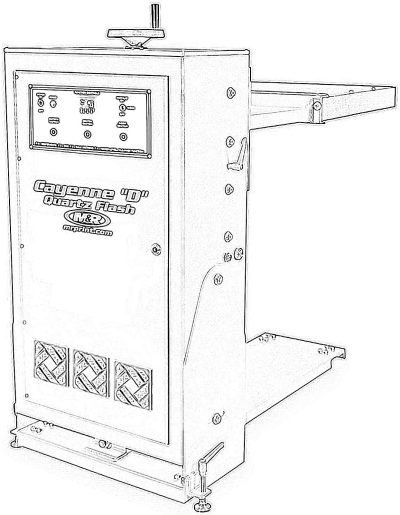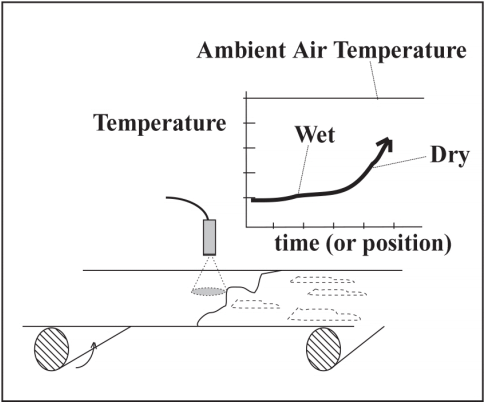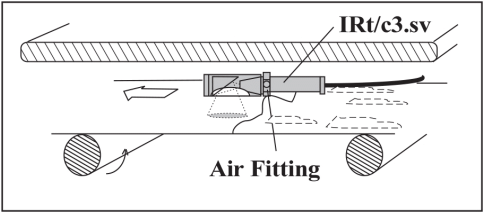
Flash cure systems are an excellent way to cure, or dry, the ink used in screen printing processes. They also offer manufacturers capabilities not possible before, including the ability to:
- Increase opacity, and create highlights and other special effects,
- Print colors on top of other colors efficiently and cleanly, particularly for certain special combinations of substrates and inks, and
- Print light-colored inks on dark backgrounds by first quickly curing-a light-colored ink under the base ink.
However, these more advanced capabilities require very accurate and consistent temperature controls. If the flash cure unit temperature is too hot, the adhesive used to hold the garment in a fixed position during printing may become gooey and it will not perform properly.
With excessive heat, the adhesive may adhere to the garment when removed from the pallet, and result in a sticky, tacky layer on the inside of the shirt. Overheating may also burn the garment or related equipment, such as pallets.
If the flash cure temperature is too cool, the ink may not fully cure and will not stand up to a washing. Any of these issues mean that manufacturers are wasting precious time and energy – ultimately having a negative impact on the bottom line.
Control
One obvious solution to controlling flash cure system temperatures is a temperature sensor; but manufacturers need to be aware of some challenges that can occur when using a sensor with flash cure systems. A number of issues inherent in the curing process can adversely impact the accuracy of a temperature sensor.
For example, the intense heat from the curing lamps can push a sensor's body temperature past its specified maximum, increasing the risk for sensor failure or errors. Even after normal machine shut down, residual heat from the flash curing lamps and their components may still be strong enough to push a sensor's body temperature past its limit, again increasing the risk for sensor failure. And, the sensor's proximity to the lamps used in the curing process can potentially restrict the sensor's view of the garment, impeding accurate measures.
A Solution to Ensure Accurate Temperature Readings in Flash Cure Systems
A very effective solution to ensure accurate temperature measures in flash cure systems entails the use of non-contact, infrared (IR) temperature sensors with embedded contact thermocouples. In particular, a self-powered sensor is an ideal choice for this application, because it is intrinsically safe, and some units available on the market today offer repeatability of 0.02°F (0.01°C), resolution of as much as 0.0003°C and interchangeability of ± 1%. These specs ensure consistent measures that are critically important in the high intensity heat environment common with flash cure systems.
With a self-powered, non-contact, IR temperature sensor as the basis for a solution, the following customization can be done to increase curing speed, and eliminate the possibility of restricting the sensor's view or surpassing its maximum body temperature.
The challenge presented by the sensor overheating during operation can be solved simply and cost- effectively with a baffle system. The baffle system should be comprised of several pieces of aluminum and stainless steel, with the sensor integrated. Since the aluminum block is +25°C (+80°F) ambient and is very conductive, it will absorb any "excess" heat. It will take a certain amount of time for the aluminum to heat up, and normal cooling down of the machine also takes a set time, so the amount of aluminum must be calculated properly to ensure that the temperature of the sensor does not exceed +100°C (+200°F).

Fig. 1: A baffle system comprised of several pieces of aluminum and stainless steel, with the sensor integrated.
The baffle system can also be used to direct air from the curing system's fan to the sensor area. Together, air plus the baffle materials and related components ensure that the ambient temperature will never be higher than +100°C.

Fig. 2: Directing air from the curing system's fan to the sensor area.
To prevent the sensor from overheating after the flash cure units are shut down, a ventilation system should be installed to cool the sensor. In order to safeguard against fan failure that might occur due to power outages, the sensor should be integrated with an aluminum heat sink. The aluminum heat sink's conductive abilities work to absorb the ambient heat without raising the temperature of the sensor excessively.

Fig. 3: IR sensor should be integrated with an aluminum heat sink.
Last Step
Finally, in order to prevent the lamps from restricting the sensor's view of the garment and impeding accurate measures, two double-walled, stainless steel shrouds can be used to cover the sensor's field of view from the lamps. The shrouds insulate the sensor, preventing any direct lamp energy from impacting its measurements and also become part of the sensor's optical system, helping to keep its lens clean. The stainless steel shroud's reflective quality not only reduces the heat, but also has the added benefit of effectively creating a wider field of view, which is more desirable from a quality control perspective.
In Essence
The customized sensor solution allows use of the higher intensity lamps that many flash cure units need to speed ink curing, while providing the reliable and accurate temperature readings to determine exactly when to remove t-shirts from the curing unit. With the customized sensor solution, users have been able to increase flash cure system drying speeds up to 15%.
About the Author
Bart van Liempd, General Manager of Exergen Global BV, Industrial OEM Sales, joined the company in 1994, after spending 8 years as CEO of an OEM business that designed and supplied Electronic Power Controllers to the graphics and semiconductor industry. Bart's years of experience and knowledge has helped Exergen become the number one IR sensor supplier in the world, custom designing sensors for printing industry companies including Hewlett-Packard, Heidelberg, Xerox, Kodak, Technotrans, Baldwin and many others.
Related Stories
Elbit System of America Provides Airmen Advanced Solutions for Mission Success
Position-tracking System Captures and Displays Real-Time Data to Improve Sports Teams' Performance
Replacing Laser Diodes With LEDs, And Vice Versa